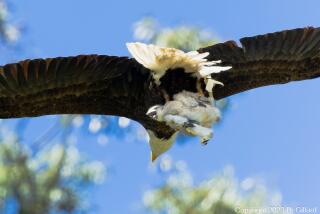‘Egg-Bound’ Condition, Bird Diet Not Linked
- Share via
Q I plan to get a pair of cockateels for my family with the idea of breeding the birds. I have had other birds and am somewhat familiar with their habits and needs.
I was warned, however, to observe my birds closely when it comes time for the female to lay eggs because she might become “egg-bound.” What exactly does this mean, and what should I be looking for? Is this a particular problem with cockateels? Will diet help prevent the problem?
Mrs. Shane Porter,
Los Alamitos
A The condition commonly called egg-bound can occur in any breed of bird, and diet is not a direct cause. The condition occurs while the egg develops and descends down the reproductive tract.
Occasionally, a large shell may develop and become difficult to pass normally. You will notice the female become listless, weak and stop eating if the condition goes unchecked. Often the first sign is a large bulge at the vent, and the shell may be visible. The abdomen will also appear to be distended and the bird will appear to be distressed. You should handle this bird with the utmost care.
When you notice that your bird may be egg-bound, I recommend that you have her seen by a veterinarian who treats birds. It may be possible to assist in the removal of the egg by using lubricants and gentle massage.
In some cases, surgery may be necessary to keep the egg intact and prevent further injury to the female. It may also be necessary to gently break the egg and remove the contents and shell fragments if no other way is possible.
If the condition is left unchecked, a severely bound bird can die. Fortunately, most birds have no problems with laying eggs.
Q Two weeks ago, my male cat got into a fight with another cat and developed an abscess as well as a split ear. Both healed within a short period, but now his ear is notched and looks awful. Is it possible to have his ear repaired to look normal? My husband thinks that it gives him character and that I should leave it alone.
Mrs. A. Seigers,
Stanton
A You will need to have your cat examined by your veterinarian to assess the amount of damage and scarring to the ear flap or pinna.
If the ear is badly thickened from scar tissue and fibrin, it may be very difficult to restore the ear to normal. A simple tear would be much easier to fix, although any trauma to the pinna, surgery included, could lead to scarring and a deformity in shape and thickness.
In some cases, implants or preformed supports can be used to maintain a normal pinna. If you have this done, I recommend that you have your cat neutered at the same time. It may help reduce the incidences of fighting.
Got a question about your pet? Write Dr. Glenn Ericson, Ask the Vet, Orange County Life, The Times, 1375 Sunflower Ave., Costa Mesa, Calif. 92626.
More to Read
Sign up for Essential California
The most important California stories and recommendations in your inbox every morning.
You may occasionally receive promotional content from the Los Angeles Times.













